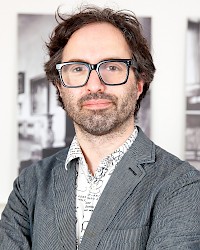Vita
Emanuele Coccia is associate Professor at the École des Hautes Études en
Sciences Sociales (EHESS) in Paris. After a doctorate in medieval philosophy and philology at the University of Florence, he received post-doctoral grants at the Max Planck Institut in Frankfurt am Main, the CNRS and the Universitat Autonoma di Barcelona. He was assistant professor at the University of Freiburg in Breisgau. He regularly teaches in fashion schools. He was an invited professor at the universities of Buenos Aires, Tokyo and Duesseldorf and spent a year of research at the Italian Academy for Advanced Studies in America at Columbia University in New York. After working on the history of European normativity and on aesthetics, his current research focuses on conceptions of life on the one hand and on the ontological status and normative power of images in fashion and advertising on the other. Among his publications are The Life of Plants: A Metaphysics of Mixture (2018), : Goods: Advertising, Urban Space and the Moral Law of the Image (2018), Sensible Life. A Micro-Ontology of the Image (New York 2016). Together with Giorgio Agamben he edited an antology on angels in Judaism, Christianity and Islam Angeli. Ebraismo Cristianesimo Islam (2009). Together with Donatien Grau he published an inquiry on the birth of the concept store The Transitory Museum (2018).
Dated from 2019
IKKM Research Project
In modern globalized societies it is images, more than words, that are responsible for the shaping of social customs and practices; since the invention of cinema and photojournalism up to the predominance of iconic communication in social networks such as Instagram or Snapchat contemporary societies seem to express and formulate in an iconic way their deepest and most effective social rules. Conversely images, which in the past had mainly an aesthetic, decorative or - more rarely - a cognitive function, are becoming today more and more the organs of a new form of collective normativity and individual psychagogy. The birth of advertising actually responds to the need to make images the main tool for the enunciation of social norms. Conversely, advertising changed the status of images themselves. With advertising for the first time, we have seen the conscious and mass production of images whose main function is no longer the mere communication of information, nor the production of aesthetic feelings of pleasure or displeasure, but the realization of a norm. Advertising images cannot be recognized and separated from other types of images or iconic structures on the base of their content (an exclusive object), nor because of their having some unique form (a specialized language) or a peculiar message (concrete suggestions for selling things or for shopping). An image becomes advertising image simply by virtue of its performing a normative task, and not because of some material or formal features. But this normative function, by the same measure, follows patterns that are not immediately recognizable. Advertising images are not a special class of images with a special content, but just images in their normative power, images in as much they can exercise a normative function. This normative function is closely linked with their reproducibility. Or expressed provocatively: it is to advertising that we should look to understand what norms are and how they function today; and in order to explain advertising we must understand the contemporary conditions under which a social norm can be formulated as image. During my stay at the IKKM I will pay special attention to the mechanisms that allow building up an individual and subjective consciousness through images. How do we construct our identity through the use of images or iconic elements? To what extent can an image become the condition of possibility (material and objective) to be able to say I and build one's own self-consciousness? The advanced hypothesis is that fashion is the answer that contemporary material culture gives to these questions.
Selected Publications
Books:
La vie des plantes. Une métaphysique du mélange Payot et Rivages, Paris 2016 (translated into English, Italian, German, Spanish, Brazilian Portuguese, Portuguese; Dutch, Japanese, and Turkish translations forthcoming)
Le Bien dans les choses Payot et Rivages, Paris 2013 (translated into English, Italian, German, Spanish)
